These world-famous rivers are making a splash!
From short sprints down beginner rapids to multi-day excursions through magnificent landscapes, Idaho rivers rank among the best in the nation and sport something awesome for everyone at all experience levels.
Local guide companies boast seasoned experts who are sure to lead you on great adventures, so whether you’ve lived here awhile or just recently started calling the Gem State your home, we believe you deserve a taste of the adventure.
As your local real estate experts, we want everyone to love where they live. We’ve spent the past 30 years helping thousands of families settle into great homes near Boise, and if you haven’t been introduced to the thrill of river rafting, we hope this gives the boost of inspiration you’ve been looking for.
Picture this: it’s Saturday morning and the sun is just starting to peek through your window. Normally you’d roll back over and try to catch some more sleep, but this is no ordinary Saturday morning.
Instead of sitting sleepily on the couch while trying to put off all the cleaning that’s piled up, you’re packing your bags to go paddle down the river, splash through some rapids and chase the breathtaking views that can only be found around the next bend.
It’s the moment you’ve been dreaming about all week, and now it’s finally here. All that’s left to do is load up the car and wave goodbye to your neighbor who’s doing yard work this weekend.
To those who already own a PFD and know how to hit a perfect line, you’ll find some helpful resources below that will help you start planning your next day trip near Boise.
If you read that last sentence and thought we misspelled “.pdf,” you’re either spending too much time in the office or haven’t spent enough time on the river yet, and that’s okay! The following sections will bring you up to speed and inspire you to push-off confidently into your next whitewater adventure.
Definition: PFD stands for Personal Flotation Device. It’s one of the most commonly used abbreviations in whitewater sports and is the more professional way to say “life jacket.”
Awesome River Rafting Near Boise
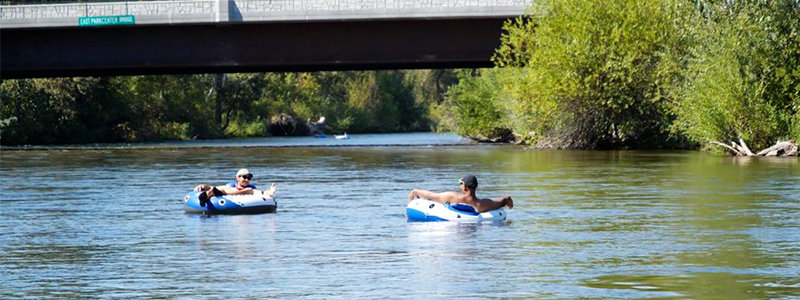
Boise River
Distance from Boise: 0 minutes… it’s right downtown!
The Boise River is easily accessible with multiple put-in locations near downtown Boise, and Boise River Raft & Tube offers a great float map you can use to chart your next float.
And for those who love to surf, be sure to check out the Boise Whitewater Park courtesy of the J.A. and Kathryn Albertson Family Foundation. They set up live webcam feeds to make it easy to see how busy it is before heading down to play in the waves (or watch people wipeout, whatever floats your boat).
Definition: “Put-in” simply means the place where you enter the river. Frequent river-goers can often be heard saying “I’ll meet you at the put-in,” or “We talked to them at the put-in ramp.”
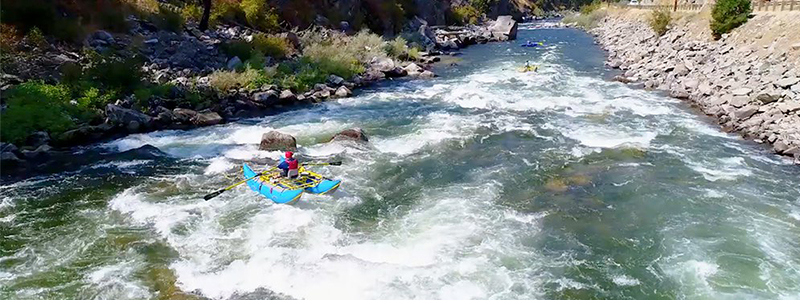
Payette River
Distance from Boise: 45-minute drive
The Main Payette River is an Idaho classic, providing plenty of pool and drop rapids ranging from Class II to Class III. This is one of the best places for beginners to go whitewater rafting in the US, so if you’re still learning, this is an ideal training ground.
Definition: “Confluence” is the point where two rivers meet, and the Payette River is formed by the confluence of the North Fork Payette River and South Fork Payette River in Boise National Forest.
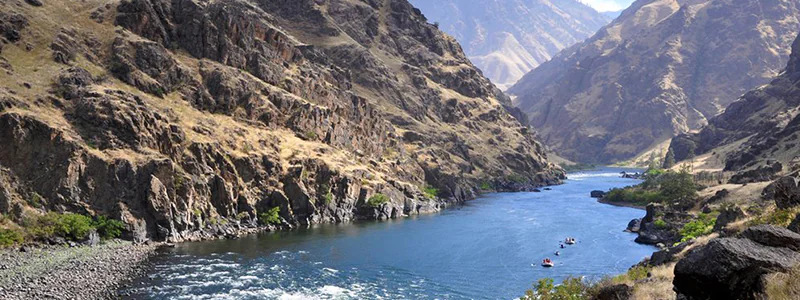
Snake River
Distance from Boise: 1 – 3 hour drive
Few rivers offer thrills like the Snake River bordering Western Idaho and Eastern Oregon. The excitement of rafting Hells Canyon is nearly unmatched. The canyon is North America’s deepest gorge, dropping nearly 8,000 feet! Tales of this experience are what first drew whitewater enthusiasts to the Snake River and the rapids here combine for a whitewater trip you’ll remember for a lifetime!
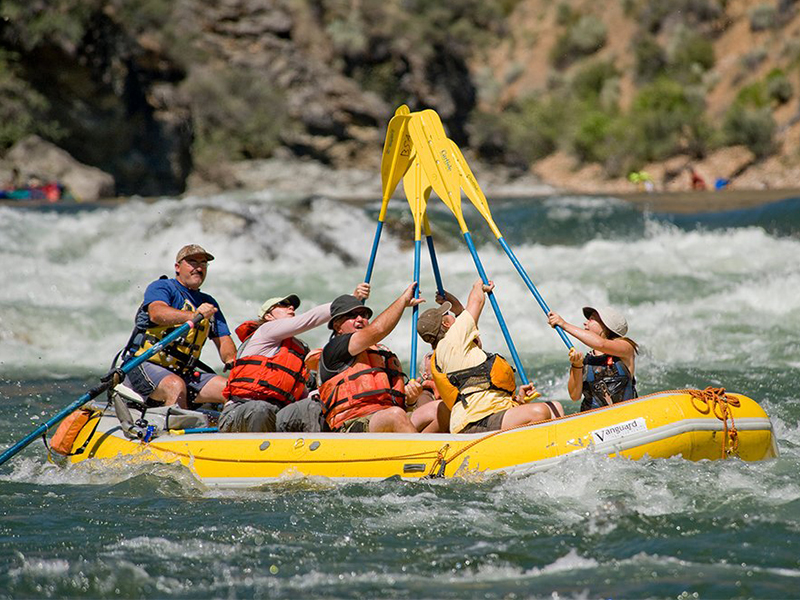
Salmon River
Distance from Boise: 3 – 4 hour drive
With close to 300 challenging rapids, the Salmon River is an adrenaline junky’s paradise. This river often ranks among the best in the world, so tackling this stretch of water needs to be on your bucket list.
Multiple rapid sets rank as Class III and IV categories (rapids change day-by-day based on water flows). Floaters sometimes run across black bears, bighorn sheep, eagles and mountain lions, so keep your eyes peeled when cruising through the calmer sections of water.
And for those with more time on their hands, plan to visit the hot springs or set up camp at one of the many campsites on the banks. All these features combine to make the Salmon River a world-class whitewater destination.
Definition: “Class III and Class IV” are rapid classifications found on the International Scale of River Difficulty. Class I Rapids are the easiest to navigate, while Class V Rapids are the most difficult. Class III and Class IV rapids require good boat control through tight spaces, fast maneuvers, and advanced rescue skills.
3 Essential Resources For Whitewater Guides in Idaho
- Real-Time StreamFlows For Idaho Rivers
- The Ultimate Gear Checklists: camping, fishing, rafting and kayaking
- Obtaining A Water Permit In Idaho
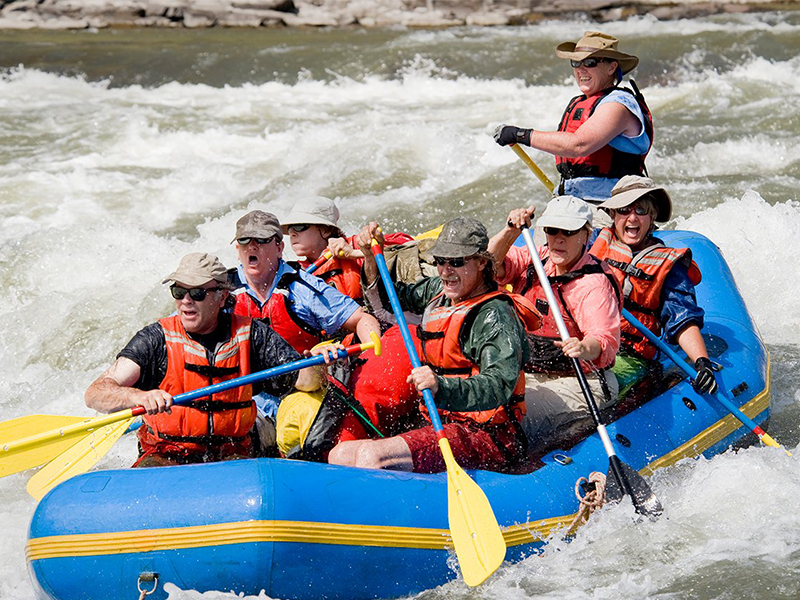
Great Whitewater Guide Companies Near Boise
Every paddler is unique, which means no guide company can truly be recommended as “the best one for you.” One thing is for sure, these guide companies spend the most time running these rivers and are best equipped to lead you on some epic adventures!
Take a little time to click through these sites, make some calls, and determine the best whitewater guide company for your next excursion. Some of these websites may look better than others, but remember, the true measure of a great guide company is their ability to win your trust and lead a fun, safe trip.
Listed alphabetically
America’s Rafting Company
Bear Valley Rafting
Boise River Raft & Tube
Cascade Raft & Kayak
Idaho Whitewater Unlimited
Momentum River Expeditions
Payette Rafting Company
What Rapids Are Best for Beginners?
If you’re new to the world of whitewater rafting, it’s best to find a nearby guide company and sign up for a trip through Class II and Class III rapids.
These rapids are commonly used for family-friendly trips, providing lots of splashing and fun challenges without requiring paddlers to know many technical skills or encounter big safety risks. An experienced raft guide will front-load these trips, giving clear instructions that most age groups should be able to learn rather quickly.
Definition: “Front-load” is a term used when describing the information given to groups before the start of a trip. It’s like a fun way to say “briefing” and usually happens after you’ve geared up and before you head down to the boat ramp.
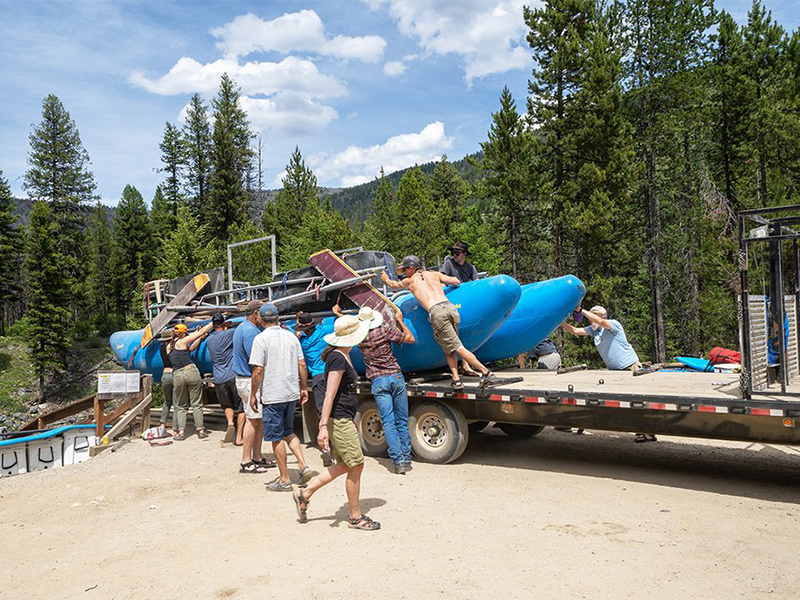
River Etiquette You Should Know
River Etiquette is important for everyone to follow, regardless of how much time you’ve spent on the water. Familiarize yourself with this list and remember that you play an important part in keeping river trips safe and fun for all those around you.
1. Boat Ramps
This is where you encounter the most people and your experiences here could set the tone for the day.
- Be kind, you never know who you’ll see again or who you might need for help further downstream
- Keep ramps clear, it’s frustrating to work around other groups who take up more space than they need
2. On The River
- Be a good neighbor, say hi to people and be willing to share the river
- Keep the noise down, remember that sound travels over water
- Leave space and ask before you pass
3. Camping
- Know how to RSVP, some campsites are first-come-first-serve while others operate on a reservation system. Do some research before you camp
- Be Goldilocks, pick a campsite that’s just the right size for your group and leave room for neighbors to settle in
4. Accidents & Injuries
- Lend a hand where you can, and if a group looks to be struggling, swing by and ask if they need help
Remember:
- Don’t risk the safety of your group to help another
- When helping others, assist them, don’t take over
Ready To Move Closer To The Adventure?
If reading about these adventures has made you think twice about where you live, we might be able to help. As local real estate experts, we’ve spent the past 30 years helping people just like you find the perfect homes here in the Treasure Valley.
It’s possible to find a better work-life balance, and we’re here to help. To learn more about your options, you can view all the current home listings near Boise on our website.
Have fun exploring Idaho!
The Mike Brown Group
Bonus: 17 Common River Terms To Know
- PFD – Personal Flotation Device, otherwise known as a life jacket
- T-grip – the “t” shaped end of your paddle
- Thwarts – an inflated crosspiece used to give structural support to the outer edges of a raft. These are sometimes mistaken for seats.
- Ride the bull – when someone sits on the nose of the raft, holding onto a strap or D-ring, while going through a rapid
- Dig – an instruction given by guides to plant paddles deeper into the water
- River left – the left-handed side of the river when looking downstream
- River right – the right-handed side of the river when looking downstream
- Eddy – A calm spot or pool in the river caused by a break in the current further upstream. These are often used for rest, rescues, or re-entry into a rapid.
- Eddy Out – an instruction used to leave the main current and enter an eddy
- Eddy Line – the line between the upstream current of the eddy and the downstream current of the main river flow
- Drop – An abrupt descent in a river
- Ferry – The act of crossing the river without going downstream, usually by maintaining a 45 degree angle upstream.
- Portage – To carry the boats around a rapid or obstacle.
- Strainer – An opening where water can flow through, but a solid like a person or boat, cannot. Usually formed by trees on the banks, cattle fences, or rocks stacked on top of each other with water flowing through them. Avoid at all costs!
- Take-out – The place where you remove your boat from the water
- Throw Bag – A rescue rope that is easily stored in a stuff sack without tangling or knotting.
- Tongue – The smooth “v” of fast water found at the head of rapids.

